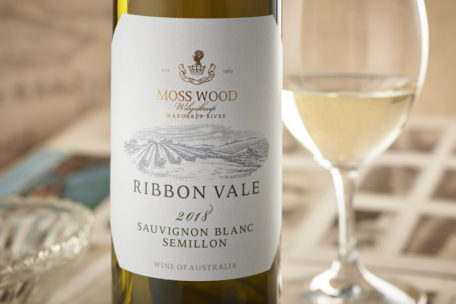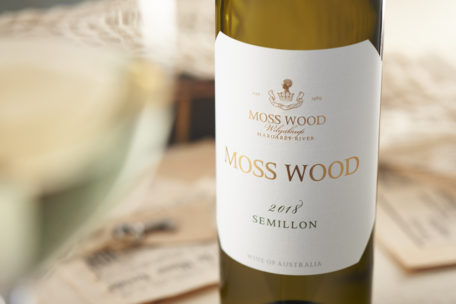Wine Notes
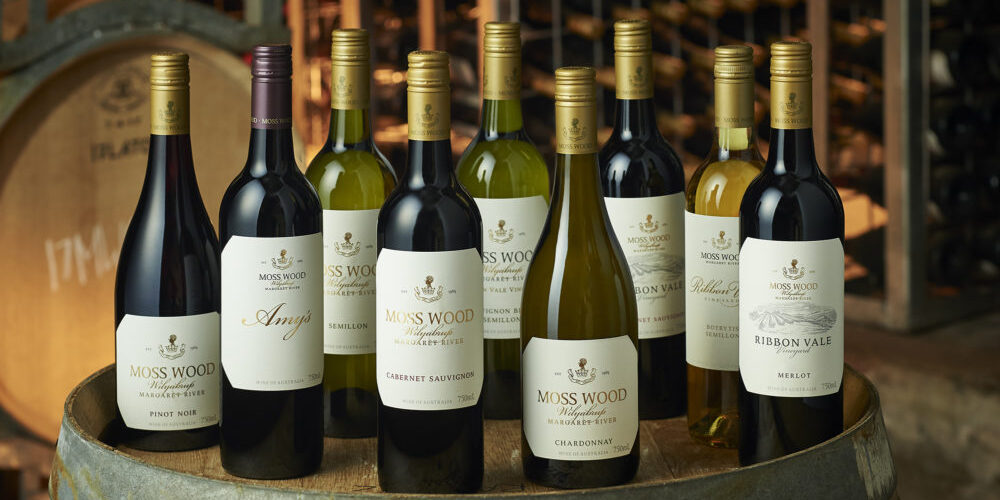
Wines made from the
MOSS WOOD VINEYARD:
Moss Wood Cabernet Sauvignon
Moss Wood Chardonnay
Moss Wood Pinot Noir
Moss Wood Semillon
Wines made from the
RIBBON VALE VINEYARD:
Moss Wood Ribbon Vale Cabernet Sauvignon
Moss Wood Ribbon Vale Merlot
Moss Wood Ribbon Vale Sauvignon Blanc Semillon
Moss Wood Ribbon Vale Botrytis Sauvignon Blanc Semillon
Wines made from the
GLENMORE VINEYARD:
Moss Wood Amy’s
A blend of Cabernet Sauvignon,
Petit Verdot,
Malbec and Merlot
Moss Wood is a family owned wine company and a pioneer of the Margaret River region.
Planted in 1969 Moss Wood is an important, founding estate of the Margaret River wine region, located in the northern sub–region of Wilyabrup, Western Australia.
Moss Wood was established as a specialist, high-quality vineyard and winery. This was its raison d’être and continues to provide the motivation for its existence. Clare & Keith Mugford, have been tending the vineyard and making wine at Moss Wood since 1984 and 1979, respectively. They believe that all decisions made in the vineyard and winery underpin the quality of the wine.
Their exacting viticulture ensures the production of grapes of excellent quality & they have created a stable of fine wines distinguished by their consistency over each vintage & their ability to age superbly.
The Moss Wood and Mugford names are synonymous with uncompromising quality.
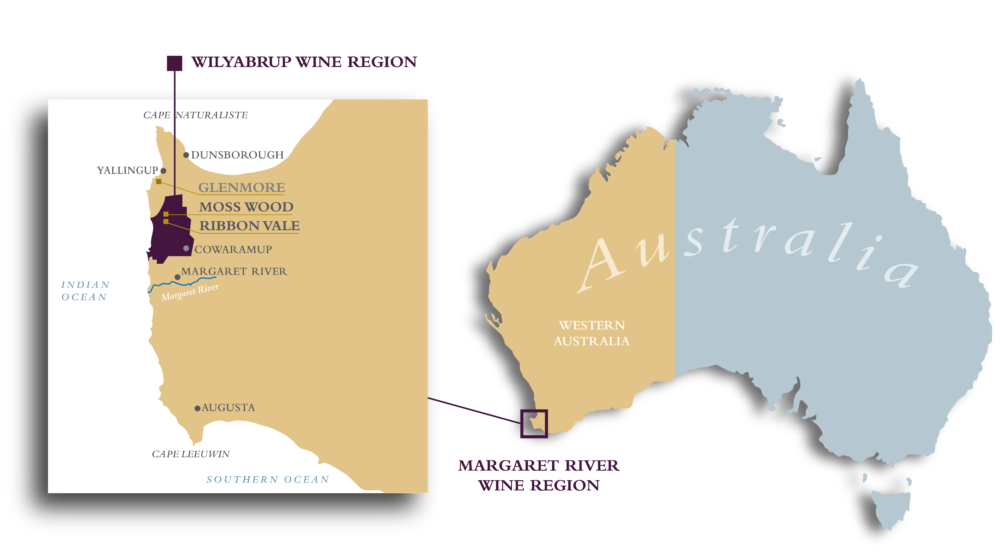
VINEYARD
The Moss Wood and Ribbon Vale Vineyards are located in the Wilyabrup sub-region, the heart of the Margaret River wine region.
At 33° 78’ south latitude, 115° 18’ east longitude and approximately three hours drive south of Perth, Western Australia’s capital city, Margaret River is recognised as one of the world’s great wine producing regions.
MOSS WOOD
VINEYARD
First planted in 1969
14.8 hectares
Grape varieties grown at the Moss Wood vineyard are:
Cabernet Sauvignon,
Chardonnay, Semillon,
Pinot Noir, Petit Verdot and
Cabernet Franc.
RIBBON VALE
VINEYARD
First planted in 1977
8.2 hectares
Grape varieties grown at the
Ribbon Vale vineyard are:
Cabernet Sauvignon, Merlot,
Cabernet Franc, Sauvignon
Blanc and Semillon.
GLENMORE
VINEYARD
– where the grapes for Amy’s
have been sourced since 1997.
First planted in 1990
Owned by Ian Bell who worked at Moss Wood for 20 years.
Grape varieties grown at Glenmore vineyard are:
Cabernet Sauvignon, Petit
Verdot, Malbec, Merlot.
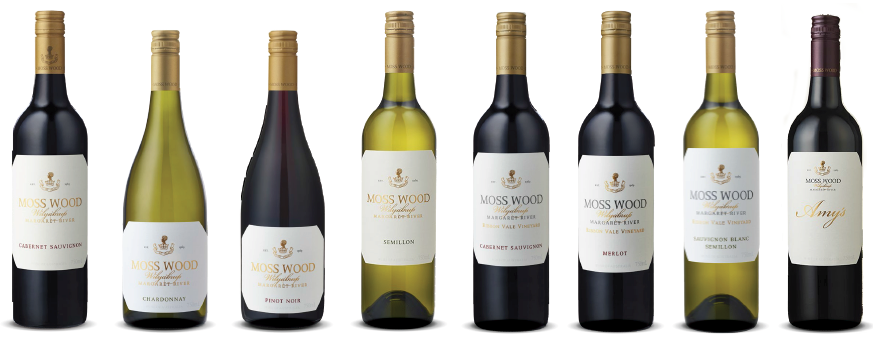
WINE FACTS |
|
| Median Harvest: | Sauvignon Blanc – 21st February, 2018 Semillon – 15th March, 2018 |
| Bottled: | 10/07/2018 |
| Released: | 08/11/2018 |
| Yield: | Sauvignon Blanc – 13.97 t/ha Semillon – 11.47 t/ha |
| Baume: | Sauvignon Blanc –11.2° Baume Semillon – 13.5° Baume |
| Alcohol: | 12.5% |
PRODUCTION NOTES
Having raw material of this quality meant that in the winery our aim was to make sure we got it safely in to bottle. For both varieties, the hand-picked fruit was whole bunch pressed and the juice was settled in stainless tank. The clear juice was racked to stainless steel, fermentation was commenced with multiple yeast strains and after 4 days, the must was racked to barrels. All were 228 litre French barriques but none were new, because we are only seeking the textural improvement rather than oak character.
After fermentation was completed, all the barrels were racked to stainless steel, with final blend being 74% Sauvignon Blanc and 26% Semillon.
Fining trials were then carried out and the wine was treated only with bentonite for protein stability. The balance of the wine was excellent and no improvement was found using the proteinaceous agents, egg white or skim milk. It was then sterile filtered and bottled on 6th July, 2018.
WINE FACTS |
|
| Median Harvest Date: | 23/03/2017 |
| Bottled: | 11 /07/2017 |
| Released: | 17/10/2017 |
| Yield: | 6.48 t/ha |
| Mean Harvest Ripeness | 12.5⁰ Baume |
| Alcohol: | 13.5% |
PRODUCTION NOTES
The fruit was hand-picked, whole bunch pressed and the juice was settled in stainless steel for 48 hours. The clear juice was then racked to stainless steel, where it was fermented using multiple yeast strains, with the temperature controlled at 18⁰C. After fermentation the finished wine was racked off lees, fined with bentonite for protein stability, then sterile filtered and bottled on 11th July, 2017.
WINE FACTS
| Harvested: | 20/02/2014 |
| Bottled: | 07/07/2014 |
| Released: | 20/11/2014 |
| Yield: | t/ha |
| Baume: | 13.00 |
| Alcohol: | 13.5% |
| Vintage Rating: | 9.5/10 |
PRODUCTION NOTES
All fruit was hand harvested and delivered immediately to the winery and destemmed, crushed, chilled and transferred into the press. The juice was extracted pumped to a stainless steel tank where it was settled for 48 hours and then racked, with a small percentage of solids, to a second stainless steel tank. It was then seeded with pure yeast culture and allowed to ferment at 18⁰C. Once dryness was reached, the wine was racked off its gross lees and prepared for bottling.
Fining trials were carried out and it was decided to treat the wine with bentonite, for heat stability and with gelatine, to improve tannin balance. The wine was sterile filtered and bottled on 7th July, 2014.
WINE FACTS
| Harvested: | 14/2/2007 |
| Bottled: | 08/6/2007 |
| Released: | 07/11/2007 |
| Yield: | 7.68 t/ha |
| Baume: | 12.50 |
| Alcohol: | 14.00% |
PRODUCTION NOTES
There were some changes to our approach to Semillon this year, each block was picked according to revised criteria: catching the grapes just before the green characters are lost. There were also some changes to the production techniques with no whole bunch pressing as we returned to the more traditional technique of destemming before pressing. This gives a small amount of skin contact as the fruit goes through the press and has the added advantage of speeding up the process. Fermentation took place as normal in stainless steel tanks held at 18°C, with weekly lees stirring. After the fermentation had been completed, there was a reduction in the amount of lees stirring to emphasise the wine’s primary fruit notes. Before bottling it was fined for protein stabilisation (using bentonite) and tannin (using isinglass). It was sterile filtered and bottled on 9th June 2007.
WINE FACTS
| Harvested: | 04/03/1993 |
| Bottled: | 18/07/1993 |
| Released: | 14/10/1993 |
| Baume: | 12.70 |
| Alcohol: | 13.00% |
| Vintage Rating: | 10/10 |
WINE FACTS
| Median Harvest: | 21/03/2017 |
| Bottled: | 09/08/2018 |
| Released: | 26/10/2018 |
| Yield: | 6.15 t/ha |
| Median Harvest Ripeness: | 13.1⁰ Baume |
| Alcohol: | 13.5% |
PRODUCTION NOTES
Everything came together on 21st March when this sound fruit was hand picked and delivered to the winery, where it was sorted then wholebunch pressed. After settling in stainless steel, the clear juice was racked and seeded for fermentation. These days we use multiple yeasts, acknowledging the complexity they bring to the wine, without the inherent quality risks of off odours and stuck fermentations associated with using wild yeasts.
As a brief explanation as to the impact on the Moss Wood Chardonnay style, the yeasts essentially bring two components to a wine. On the nose, the nearsubliminal complex aromas, usually described as earthy, akin to mushroom and truffle, occasionally presenting as more obvious sulphide-derived compounds. We prefer former, of course. On the palate, they enhance a wine’s mouthfeel by producing more glycerol, although this effect can really only be noticed when the alcohol is below 12%.
Once primary fermentation was underway, the juice was racked to 228 litre French oak barrels, of which 48% were new and this was followed by a full malolactic fermentation. At this point, all the barrels were combined and the blended wine was returned to oak, where it stayed for a total of 16 months.
At the end of July 2018, the wine was racked and blended in stainless steel in preparation for bottling. Fining trials were carried out and after tasting it was decided to fine only with bentonite for protein stability. The wine was then sterile filtered and bottled on 10th August, 2018.
WINE FACTS
| Median Harvest: | 26/02/2016 |
| Bottled: | 02/08/2017 |
| Released: | 20/08/2017 |
| Yield: | 6.32 t/ha |
| Median Harvest Ripeness: | 12.6⁰ Baume |
| Alcohol: | 13.5% |
PRODUCTION NOTES
All the fruit was hand-picked, whole bunch pressed and then the juice was settled in stainless steel tank for 48 hours. Once clarified, it was seeded with a mixture of different yeast cultures and racked to wood for the primary and malolactic fermentations. All the barrels were 228 litre French oak and 50% were new.
After 16 months, all the barrels were racked and blended in stainless steel. Fining trials were carried out and the wine was fined with bentonite for protein stability and no other treatments were necessary. It was then sterile filtered and bottled on 2nd August, 2017.
WINE FACTS
| Harvested: | 9/2/2007 |
| Bottled: | 30/1/2008 |
| Released: | 10/3/2009 |
| Yield: | 9.88 t/ha |
| Baume: | 13.00 |
| Alcohol: | 14.50% |
| Vintage Rating: | 9/10 |
PRODUCTION NOTES
The method by which the wine was made is that traditionally used at Moss Wood. The grapes are hand picked, destemmed and then pressed. The juice was then chilled and settled for a couple of days before fermentation was begun with pure yeast culture. After 48 hours, the fermenting must was racked into 100% new French barriques where it completed the primary fermentation. The usual coopers – Remond, Rousseau, Cadus and Seguin Moreau – were used. There was a continuation of the policy, introduced last year, of only stirring the lees once a week until the malolactic fermentation. As expected, we feel that this enhanced the wine’s fruit freshness.
The wine was then inoculated and about 30% went through the malolactic fermentation. After that the wine was racked into tank, adjusted for acidity and sulphur dioxide, and returned to barrels on its lees until January this year. It was racked from barrel, checked, fined with bentonite for protein stability and isinglass for tannins, cold stabilised, and then sterile filtered and bottled. This leads to our final point on the vagaries of chardonnay yields. Altogether, just 1315 dozen of the 2007 came down the bottling line: well up from the previous year’s 380.
WINE FACTS
| Harvested: | 3/3/1993 |
| Bottled: | 24/1/1994 |
| Released: | 12/4/1994 |
| Yield: | 4.05 t/ha |
| Baume: | 13.60 |
| Alcohol: | 14.50% |
| Vintage Rating: | 9/10 |
PRODUCTION NOTES
The wine was made according to standard practice at the winery since 1990: it is crushed and drained, then settled for 48 hours after which time the clear juice is racked off and fermented to half way mark in stainless steel and then racked to new oak. The development of secondary characters in the wine, and hence complexity, is encouraged by allowing the wine to undergo a malolactic fermentation and by aging all of it on its lees in new French oak for nine months. The primary characters, especially the natural fruitiness of the Moss Wood Chardonnay, are preserved by only allowing half to go through the malo.
WINE FACTS
| Median Harvest: | 10/02/2016 |
| Bottled: | 14/11/2017 |
| Released: | 26/10/2018 |
| Yield: | 4.43 t/ha |
| Median Harvest Ripeness: | 13.9⁰ Baume |
| Alcohol: | 14.5% |
PRODUCTION NOTES
At harvest time, the technique was classic Moss Wood. The fruit was hand harvested, destemmed, apart from an inclusion of 5% whole bunches and placed into small, open fermenters. The must was chilled to 8°C and allowed to soak for 48 hours, after which it warmed to ambient temperature and was seeded for fermentation with multiple yeast strains. All tanks were hand-plunged 3 times per day. Each batch was tasted daily to monitor tannin extraction and balance and pressed after 18 days on skins.
After pressing, each batch underwent malolactic fermentation in stainless steel and they were then racked to wood in the second week of March 2016. All barrels were 228 litre French oak barriques, and 17% were new.
On 3rd November, 2017, all the barrels were racked to stainless steel and fining trials were conducted on the final blend. In what is a very rare thing, we decided the wine was improved using a very small dose of gelatin, making it the first and only Moss Wood Pinot Noir treated with that agent. It was sterile filtered and bottled on 13th November, 2017.
WINE FACTS
| Harvested: | 25/2/2009 |
| Bottled: | 14/1/2011 |
| Released: | 9/11/2012 |
| Yield: | 4.03 t/ha |
| Baume: | 13.30 |
| Alcohol: | 13.50% |
| Vintage Rating: | 9/10 |
PRODUCTION NOTES
All the fruit was hand harvested. Processing at the winery was typical for Moss Wood Pinot Noir, with destemming into small, open, stainless stell fermenters, where the must was chilled down to 8⁰C and allowed to cold soak for 48 hours before being seeded with a pure yeast culture. Fermentation then proceeded at temperatures up to 30⁰C and were hand plunged up to 4 times per day for extraction. After 14 days on skins each batch was pressed, racked to barrel and underwent malolactic fermentation. After this was completed the wine was racked, adjusted and returned to barrel, where it stayed until December 2010.
In preparation for bottling, fining trials were carried out but the wine was well balanced and fining was not required. It was then sterile filtered and bottled on 14th January, 2011.
WINE FACTS
| Harvested: | 15/2/2001 |
| Bottled: | 10/8/2002 |
| Released: | 16/10/2003 |
| Yield: | 10 t/ha |
| Baume: | 13.70 |
| Alcohol: | 14.00% |
| Vintage Rating: | 9/10 |
PRODUCTION NOTES
In contrast to the vineyard, winery production techniques have changed very little. The fruit was hand picked and then 95% was de-stemmed into open fermenters while the remaining 5% was included as whole bunches. The must was then chilled down to 10C, cold soaked for 3 days and pumped over twice per day. Each batch was then seeded with a pure yeast culture and allowed to ferment up to 32C. Plunging was done 4 times per day and the wine was pressed after 14 days on skins. All pressings were included and the wine was racked into barrel for malolactic fermentation. It stayed in French oak barriques for 22 months and was fined, filtered and bottled in March 2003.
WINE FACTS
| Harvested: | 27/2/1992 |
| Bottled: | 17/11/1993 |
| Released: | 11/10/1994 |
| Yield: | 8.80 t/ha |
| Baume: | 13.50 |
| Alcohol: | 13.5% |
| Vintage Rating: | 8/10 |
PRODUCTION NOTES
The 1992 Pinot Noir is something of a surprise packet at Moss Wood, especially after two fine vintages in 1990 and 1991. The wine is a huge, gutsy, alcoholic red that will drink well young but can be cellared with confidence.
It was made using thirty per cent uncrushed bunches according to techniques developed and refined at Moss Wood over many years. Pre fermentation, the must was cooled and pumped over for half an hour once a day, delaying the onset of fermentation by forty eight hours. This maceration enhances the fruit flavour and colour without extracting the more aggressive tannins. It is an extension of a Burgundian technique introduced by Nicholas Potel of Domaine de la Pousse d’Or when he worked at Moss Wood in 1991.
During fermentation, the must was hand plunged at least five times a day until dryness. At that stage, the ancient technique of pigeage was employed. The winemakers were immersed in the fermenters stirring the wine and stamping the whole bunches so that more sugar was released and the fermentation picked up once again. In this way, the fermentation process was lengthened and the wine remained in contact with the skins for about fourteen days. This enhances colour and tannins yet avoids any harshness or bitterness. The wine was pressed two days after the fermentation stopped the second time.
The wine went through a malolactic fermentation in stainless steel and was then transferred to barrels where it stayed for twelve months. As usual, about a third of the barrels were new with half of these coming from Allier and half from Tronais. The wine was fined, filtered and bottled in November 1993.
WINE FACTS
| Harvested: | Glenmore Cabernet Sauvignon – 24th April, 2017 Glenmore Merlot – 11th April, 2017 Glenmore Malbec – 12th April, 2017 Petit Verdot – 11th April, 2017 |
| Bottled: | 10/07/2018 |
| Released: | 08/11/2018 |
| Baume: | Glenmore Cabernet Sauvignon – 13.3° Baume Glenmore Merlot – 14.0° Baume Glenmore Malbec – 13.6° Baume Glenmore Petit Verdot – 14.7° Baume |
| Alcohol: | 13.5% |
PRODUCTION NOTES
Across all the varieties in the Amy’s blend, we use a similar technique, with fermentations in closed tanks, with pump-overs for colour and flavour extraction. Time on skins is typically shorter than the Moss Wood and Ribbon Vale reds, varying from 9 days for the Petit Verdot to 16 days for the Cabernet Sauvignon, Malbec and Merlot. After pressing, the wine was blended and then racked to 228 litre French oak barrels, although there was no new oak. Our intention is to ensure the Amy’s always has good fruit depth and so a short time in old barrels gives us sufficient complexity.
In June 2018 all barrels were racked and blended in stainless steel and assessed for tannin balance. Fining trials showed the wine to have excellent balance and so it remained untreated. It was then sterile filtered and bottled on 9th July, 2018.
The final blend is 79% Cabernet Sauvignon, 10% Merlot, 7% Malbec and 4% Petit Verdot.
WINE FACTS
| Median Harvest: |
Merlot 24/03/2016 |
| Bottled: |
09/08/2018 |
| Released: | 03/11/2018 |
| Yield: |
Merlot |
| Median Harvest Ripeness: |
Merlot |
| Alcohol: | 13.5% |
PRODUCTION NOTES
All 2 varieties were destemmed and sorted to remove any contaminating leaves and stems and Cabernet Franc were then placed into small, open fermenters. Merlot was transferred into small, closed fermenters. The reason for the variation is we have greater success in extracting Merlot’s colour and tannin in vessels that can be pumped over, not plunged. The reasons are not clear, other than to say if there’s a variety that will be different, it’s Merlot!
Fermentation for all was with multiple yeast strains, and each batch was hand-plunged, or pumped over, 3 times per day and tasted daily to monitor tannin balance. Merlot was pressed after 14 days and Cabernet Franc after 9 days. It was another noticeable feature of 2016 that the two reached good tannin balance relatively quickly compared to previous years and spent less time on skins.
After pressing each batch underwent malolactic fermentation in stainless steel and once completed, they were adjusted for acidity and SO2 and racked to barrel through March and April 2016. All barrels were 228 litre French oak of which 6% were new.
The final blends were tasted and prepared in January 2018. The Merlot looked best as a combination of 94% Merlot and 6% Cabernet Franc.
After blending in stainless steel, the finished wines were racked back to barrel where they stayed until the second week of June 2018. After blending for the final time, fining trials were carried out and the Merlot tannin balance was improved with a light egg white fining. Both wines were then sterile filtered and bottled on 9th August, 2018.
WINE FACTS
| Blend: | 89% Merlot 11% Cabernet Franc. |
| Median Harvest: | Merlot – 07/03/2014 Cabernet Franc – 04/03/2014 |
| Bottled: | 28/06/2016 |
| Released: | 26/08/2016 |
| Yield: | Merlot – 6.01 t/ha Cabernet Franc – 6.02 t/ha |
| Baume: | Merlot – 12.9⁰ Be Cabernet Franc – 12.4⁰ Be |
| Alcohol: | 14% |
| Vintage Rating: | 10/10 |
PRODUCTION NOTES
Having got half the job done, we then set about shepherding our high quality fruit carefully and safely to the bottle, applying all the usual Moss Wood techniques. Each variety was hand pick and all the fruit was destemmed into small fermenters and pumped over 3 times per day for extraction. Fermentation was by selected yeast strains and temperatures were set to a maximum of 30⁰C. Time on skins was 12 days for Cabernet Franc and 15 days for Merlot.
After pressing, each variety was racked to barrels, all 225 litre French oak. In December 2015 all batches were racked to stainless steel, tasted and the final blends assessed. The 2014 Ribbon Vale Merlot was deemed best at 89% Merlot and 11% Cabernet Franc. The blend was made up then returned to barrel for further aging. For the record, the Merlot received a total of 26 months in oak.
In June 2016 the wine was racked to stainless steel and fining trials were carried out. The balance was excellent, so the wine was left unfined. It was then sterile filtered and bottled on 28th June, 2016.
WINE FACTS
| Median Harvest: |
Cabernet Sauvignon – 23/03/2016 |
| Bottled: |
09/08/2018 |
| Released: | 03/11/2018 |
| Yield: |
Cabernet Sauvignon 4.29 t/ha |
| Median Harvest Ripeness: |
Cabernet Sauvignon 13.3⁰ Be |
| Alcohol: | 13.5% |
PRODUCTION NOTES
All 3 varieties were destemmed and sorted to remove any contaminating leaves and stems and Cabernet Sauvignon and Cabernet Franc were then placed into small, open fermenters. Merlot was transferred into small, closed fermenters. The reason for the variation is we have greater success in extracting Merlot’s colour and tannin in vessels that can be pumped over, not plunged. The reasons are not clear, other than to say if there’s a variety that will be different, it’s Merlot!
Fermentation for all was with multiple yeast strains, and each batch was hand-plunged, or pumped over, 3 times per day and tasted daily to monitor tannin balance.
Cabernet Franc was pressed after 9 days, Merlot after 14 days and Cabernet Sauvignon after 16 days. It was another noticeable feature of 2016 that all 3 reached good tannin balance relatively quickly compared to previous years and spent less time on skins.
After pressing each batch underwent malolactic fermentation in stainless steel and once completed, they were adjusted for acidity and SO2 and racked to barrel through March and April 2016. All barrels were 228 litre French oak of which 14% were new.
The final blends were tasted and prepared in January 2018. The Cabernet Sauvignon was thought best at 94% Cabernet Sauvignon, 3% Cabernet Franc and 3% Merlot. The Merlot looked best as a combination of 94% Merlot and 6% Cabernet Franc.
After blending in stainless steel, the finished wines were racked back to barrel where they stayed until the second week of June 2018. After blending for the final time, fining trials were carried out and the Cabernet Sauvignon remained unfined but the Merlot tannin balance was improved with a light egg white fining. Both wines were then sterile filtered and bottled on 9th August, 2018.
WINE FACTS
| Blend: | 94% Cabernet Sauvignon 3% Cabernet Franc 3% Merlot |
| Median Harvest: | Cabernet Sauvignon – 27/03/2015 Cabernet Franc – 04/03/2015 Merlot – 12/03/2015 |
| Bottled: | 29/08/2017 |
| Released: | 19/10/2017 |
| Yield: | Cabernet Sauvignon – 3.55 t/ha Cabernet Franc – 5.79 t/ha Merlot – 5.46 t/ha |
| Baume: | Cabernet Sauvignon – 13.7⁰ Be Cabernet Franc – 13.2⁰ Be Merlot – 12.6⁰ Be |
| Alcohol: | 14% |
PRODUCTION NOTES
The Cabernet Sauvignon was on skins for 15 days, the Merlot for 15 days and Cabernet Franc for 14 days. After fermentation the Cabernet Sauvignon was racked to barrels on 27th May 2015, the Merlot on 13th April 2015 and Cabernet Franc on 31st March 2015. All the barrels were 228 litre French oak and the Cabernet Sauvignon received 19% new and the Merlot received 9%.
In December 2016 all the batches were racked to stainless steel for blending. After blind tastings, the Cabernet Sauvignon was blended with 3% each of Merlot and Cabernet Franc. The finished wine was then returned to barrel.
On 21st August 2017 the wine was racked to stainless steel in preparation for bottling. Fining trials were carried out but none improved the wine, so it was then sterile filtered and bottled on 28th August 2017.
WINE FACTS
| Harvested: | 13/3/1996 |
| Bottled: | 30/6/1998 |
| Released: | 30/6/1999 |
| Yield: | 10.00 t/ha |
| Baume: | 13.70 |
| Alcohol: | 14.00% |
| Vintage Rating: | 10/10 |
PRODUCTION NOTES
The grapes were picked, crushed, destemmed and tipped into open tanks seeded with pure yeast culture. The juice remained on skins for an average of 8 days and for at least 24 hours after the wine had passed 0° baume. During this time, the tanks were plunged at least three times a day. Fermentation temperatures are relatively high (up to 30°C) and each batch is pumped over once towards the end of fermentation to improve colour and blow off any lingering hydrogen sulphide.
As Moss Wood now has the luxury of more fermentation space, we were able to keep the Cabernet on skins for 3 or 4 days after fermentation has finished. In doing this we are seeking to ameliorate the tannins. Time on skins can remove furry tannins and soften and improve the definition and balance of tannins. There is a point beyond which there is no improvement in this softening process. Daily tastings look for the point at which improvement ceases. The grapes are then pressed with all pressings being included in the wine.
This is then allowed to settle in stainless steel tanks and left on its gross lees until after the malolactic fermentation is completed. After that it is put into barrel – 50% in new French oak and 50% in two and three year old barrels – where it is kept for two years. The ways in which the Reserve style differs from the traditional Moss Wood Cabernet are that the wine is given two years in barrel (rather than 18 months); and 12 (rather than 6) months bottle maturation before release. This allows the development of some complex features of cabernet sauvignon – tar and smoky characters – while the wine is in oak. It also means that the Cabernet will lose some of its fresh fruit flavours without adversely affecting the wine. The additional time in bottle enables it to avoid bottle shock and any problems associated with handling it. We believe that these two changes underpin a step up in quality and takes the vineyard to a new level. We hope that this will enhance Moss Wood’s reputation as a quality producer.
WINE FACTS
| Harvested: | 30/3/1999 |
| Bottled: | 11/8/2001 |
| Released: | 2/7/2002 |
| Yield: | 9.22 t/ha |
| Baume: | 13.80 |
| Alcohol: | 14.50% |
| Vintage Rating: | 10/10 |
PRODUCTION NOTES
In the winery, the production technique was very much in our traditional mode. The fruit was crushed, de-stemmed and pumped into open fermentors. During fermentation, the tanks were hand plunged four times per day, the temperatures allowed to rise to 32°C and at the end, each ferment was pumped over once to reduce hydrogen sulphide.
At this point it is worth noting that, like all the other Moss Wood wines from the 1999 and 2000 vintages, the cabernet sauvignon was fermented with wild, not selected or pure, yeast strains. This is a departure from our traditional technique and one that was applied to enhance the texture and complexity of flavour of the wine. From a quality point of view, we were happy with the results and believe that the spontaneous fermentation did improve the wine. However, the improvement was only small and in our opinion, too small a trade off for the enormous associated risk. Accordingly, we discontinued the process after the 2000 vintage.
As each batch completed its fermentation, the wine was tasted on a daily basis to decide when to press. The time on skins varied from batch to batch but averaged out at around 12 days. After pressing, the wine is transferred to oak barrels for malolactic fermentation. It is then racked, analysed, adjusted and returned to oak. As usual, all barrels are 228 litre French Allier oak, with a medium toast – 50% were new.
The wine spent two years in barrel, after which it was racked to stainless steel tanks and prepared for bottling. The wine was not fined but it was filtered. Since then, the wine has spent the best part of a year lying in the cellar recovering from the shocks and knocks of the bottling process. This ensures that it is properly settled at the time of release, and we hope, able to meet both producer and consumer expectations.
WINE FACTS
| Harvested: | 27/3/2000 |
| Bottled: | 5/8/2002 |
| Released: | 30/6/2003 |
| Yield: | 10.00 t/ha |
| Baume: | 14.00 |
| Alcohol: | 14.50% |
| Vintage Rating: | 10/10 |
PRODUCTION NOTES
The new machine, the Delta E2 Destemmer, involves no crushing of the grapes. It destems the berries and transfers them whole, plus some juice, by conveyor belt into the fermentation tanks. The destemming means that a minimal amount of tannin is extracted. Given the 28 year difference in their age and the fact that the Delta E2 is made of stainless steel, it is scarcely surprising that the new machine is much easier to clean and so already well loved by winery staff.
The other major difference with the 2000 wine is that it was the second – and last – Moss Wood Cabernet Sauvignon in which fermentation was triggered spontaneously by strains of wild yeast.
Apart from that, production followed the traditional Moss Wood approach. Fermentation took place at warm temperatures – up to 32° Celcius. During the process, hand plunging took place four times a day. Each batch was left on skins after fermentation for between 10 and 14 days, depending on taste. After that, it was pressed and placed into barrel (50% new oak) for two years. All pressings were included in the finished wine. It was taken out of oak in July 2002, and filtered (but not fined) and bottled in August.
It was the first Moss Wood wine to be bottled partially under Stelvin (screw caps) ensuring that those bottles are not affected by cork taint. We are committed to bottling more and more using Stelvin caps. We plan to move from 200 cases of the 2000 Cabernet to 1,500 cases for the 2001. With the current vintage, Stelvin will be used for comparative tastings to show its value as a closure.
WINE FACTS
| Harvested: | 13/4/2006 |
| Bottled: | 29/4/2008 |
| Released: | 21/4/2009 |
| Yield: | 6.88 t/ha |
| Baume: | 13.00 |
| Alcohol: | 14.00% |
| Vintage Rating: | 8/10 |
PRODUCTION NOTES
The harvest ripeness for each of the varieties is chosen to give us the appropriate characters. We have discussed the manner in which we manage the vineyard to derive ripe flavours but that still leaves the question of what are the preferred characteristics.
In Cabernet Sauvignon, we a try to minimise the leafy notes in the wine and with the right vineyard techniques, these are usually lost by the time the fruit has ripened to 13 Baume. At the same time, the grapes develop their best berry characters, which are usually a combination of red currant, mulberry and blackcurrant.
Cabernet Franc has a different ripening profile. In the Moss Wood vineyard it produces less leafiness than Cabernet Sauvignon and can be picked earlier. The preferred ripeness is between 12.5 and 13 Baume, when the varietal characters are fresh berries, similar to summer pudding. Further ripening tends to produce dark plum notes which are perfectly acceptable but not as vibrant.
When still slightly green, Petit Verdot has an herbal note, more coriander than leaf and as it ripens to 13 Baume it develops an ethereal, aromatic lift, redolent of violets and sweet red berries. Sometimes it even smells like perfumed talcum powder and the intensity is such that only a small percentage is necessary in the final blend.
Once each variety is harvested, their winemaking techniques are relatively similar. Each is de-stemmed into small, open fermenters and seeded with a pure yeast culture for fermentation and then hand plunged up to four times per day. The ferment temperature is controlled to a maximum of 30C and each batch is tasted at least once per day to evaluate for off characters, colour extraction and tannin balance. As fermentation finishes we monitor the progress of the latter component quite closely and once it becomes apparent the tannin balance is no longer improving, the wine is drained off skins and pressed.
In 2006, the Cabernet Sauvignon averaged 15 days on skins, Petit Verdot was 19 days on skins and Cabernet Franc 12 days.
After pressing the wine was settled then racked off gross lees into barrel, where it underwent malolactic fermentation. All barrels were French oak barriques and 65% were new. Once the secondary fermentation was completed, the individual varieties were racked then returned to barrel and kept separate until the 14th November, when all barrels were racked and combined to complete the final blend. The finished wine was returned to barrel, where it stayed until 21st April 2008.
Fining trials were then carried out but none offered any improvements in quality so the wine was then sterile filtered and bottled on 30th April 2008.
WINE FACTS
| Harvested: | Cabernet Sauvignon – 16th March, 2015 Cabernet Franc – 4th March, 2015 Petit Verdot – 21rst March, 2015 |
| Blend: | 95% Cabernet Sauvignon 4% Cabernet Franc 1% Petit Verdot |
| Bottled: | 14/11/2017 |
| Released: | 16/03/2018 |
| Yield: | Cabernet Sauvignon – 4.31 t/ha Cabernet Franc – 3.56 t/ha Petit Verdot – 0.77 t/ha |
| Baume: | Cabernet Sauvignon – 13.1⁰ Be Cabernet Franc – 12.4⁰ Be Petit Verdot – 15.2⁰ Be |
| Alcohol: | 14% |
| Vintage rating: | 10/10 |
PRODUCTION NOTES
Each variety was handled in the same way. The fruit was hand-picked, destemmed, sorted and placed into small, open fermenters. Fermentation was carried out by multiple yeast strains and all batches were hand-plunged three times per day and temperatures were set to a maximum of 30⁰C.
The Cabernet Sauvignon batches were pressed after 16 days on skins, the Cabernet Franc after 13 days and the Petit Verdot after 14 days. All pressings were blended in straight away.
After malolactic fermentation all batches were racked to 228 litre French oak barrels, of which 14% were new.
On 29th November, 2016, all batches were racked and blended and the completed wine was returned to barrel, where it stayed until 6th November, 2017, when the final blend was assembled for bottling. The makeup is 95% Cabernet Sauvignon, 4% Cabernet Franc and 1% Petit Verdot.
Fining trials were then carried out but none of the treatments improved the wine, so it was not fined. It was then sterile filtered and bottled on 14th November, 2017.

